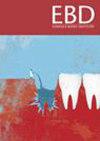Do ultrasonic instrumentation and air polishing procedures adversely affect dental restorations?
IF 2.3
Q3 Dentistry
引用次数: 0
Abstract
Esati J, Amran T, Weiger R, Alsulaimani L, Blatz M B, Eggmann F. Adverse effects of ultrasonic instrumentation and air polishing on dental restorations: a systematic review of laboratory studies. J Esthet Restor Dent 2025; https://doi.org/10.1111/jerd.13428 . A systematic review of the literature was conducted, assessing the potential for adverse effects on surface roughness and marginal integrity with use of ultrasonic instrumentation and air polishing on variety of dental restorations. With the aim to guide clinical practice to aid mitigation of adverse effects. Five databases: Cochrane Library, OpenGrey through DANS, PubMed, Scopus, and Web of Science, and supplemental manual searches were used to identify relevant literature. The review adhered to the PRISMA guidelines. Publications were included between 1978 and 2022. Population: dental restorations or restorative biomaterials in vitro. Intervention: ultrasonic instrumentation and/or air polishing. Comparison: no debridement procedure or paste polishing. Outcome: surface roughness and/or marginal quality. Forty-two laboratory studies were included in the final analysis. The studies evaluated data to answer the following research question: In specimens made of or featuring dental restorations or restorative biomaterials, how does the use of ultrasonic instrumentation and/or air polishing, compared with no debridement procedure or paste polishing, affect the surface roughness and/or marginal quality? Data extracted included: author(s) and year, laboratory studies, biomaterials evaluated, specimen quantity, specimen geometry, grouping methodology, types of ultrasonic and/or air polishing devices used, air polishing powders, device operational settings, application type and duration of ultrasonic and/or air polishing, assessments of surface roughness and marginal quality, and the observed effects on both surface roughness and marginal quality. Biomaterial assessed included: porcelain fused to metal (PFM), zirconia (ZrO2), lithium disilicate (LDS), polymer-infiltrated ceramic network material (PICN), fine-structure felspathic ceramic (FSFC), gold alloy, amalgam, resin-modified glass ionomer cements (RMGIC), conventional and flowable resin-based composite (RBC), and silorane-based RBCs restorations. Studies measured surface roughness via contact profilometry, scanning electron microscopy, and atomic force microscopy. Ra was used as a parameter for surface roughness. Stereomicroscopy and confocal laser microscopy were used to assess marginal quality. Risk of bias was assessed using the RoBDEMAT tool. Ultrasonic instrumentation and air polishing both negatively impacted surface roughness. Air polishing with sodium bicarbonate and calcium carbonate powders had a significantly greater effect on surface roughness, compared with erythritol and glycine powders. The surface roughness for RBCs and RMGICs were the most affected by ultrasonic instrumentation. In comparison, ZrO2 and LDS restorations were found to have the highest level of resistance compared to other restorations. Three studies observed that an increase in surface roughness could be mitigated using rubber cups and polishing paste after instrumentation. Ultrasonic instrumentation and air polishing methods both led to an adverse marginal quality outcome. Crowns with a narrow ceramic shoulder margin (0.7 mm) were particularly susceptible. RMGIC and amalgam restorations had a greater adverse impact on the marginal quality compared with RBC restorations. It is advised to use air polishing with less abrasive powders, including erythritol and glycine, to mitigate surface damage and changes at the marginal interface. Another important clinical consideration is the type of restorative material. High strength ceramic restorations, such as LDS and ZrO2, are much more resistant to surface roughening compared with all other materials.超声仪器和空气抛光程序对牙齿修复有不利影响吗?
[1]李建军,李建军,李建军,等。超声仪器与空气抛光对口腔修复体的影响研究综述。[J];https://doi.org/10.1111/jerd.13428目的:对文献进行系统回顾,评估超声仪器和空气抛光在各种牙科修复体中对表面粗糙度和边缘完整性的潜在不利影响。目的是指导临床实践,帮助减轻不良反应。数据来源:五个数据库:Cochrane Library、OpenGrey through DANS、PubMed、Scopus和Web of Science,并使用补充人工检索来识别相关文献。审查遵循PRISMA准则。研究选择:纳入1978 - 2022年间的出版物。人群:牙体修复体或体外修复生物材料。干预:超声波仪器和/或空气抛光。对比:无清创术,无膏体抛光。结果:表面粗糙度和/或边缘质量。最后的分析包括42项实验室研究。这些研究对数据进行了评估,以回答以下研究问题:在由牙齿修复体或修复性生物材料制成或以其为特征的标本中,与不使用清创程序或膏体抛光相比,使用超声仪器和/或空气抛光对表面粗糙度和/或边缘质量的影响如何?数据提取和合成:提取的数据包括:作者和年份、实验室研究、评估的生物材料、样品数量、样品几何形状、分组方法、使用的超声波和/或空气抛光设备的类型、空气抛光粉末、设备操作设置、超声波和/或空气抛光的应用类型和持续时间、表面粗糙度和边缘质量的评估,以及观察到的对表面粗糙度和边缘质量的影响。评估的生物材料包括:金属烤瓷(PFM)、氧化锆(ZrO2)、二硅酸锂(LDS)、聚合物浸润陶瓷网络材料(PICN)、精细结构felspathic陶瓷(FSFC)、金合金、汞合金、树脂改性玻璃离子水泥(RMGIC)、常规和可流动的树脂基复合材料(RBC)和硅烷基红细胞修复体。研究测量表面粗糙度通过接触轮廓术,扫描电子显微镜,和原子力显微镜。Ra作为表面粗糙度的参数。体视显微镜和激光共聚焦显微镜评估边缘质量。使用RoBDEMAT工具评估偏倚风险。结果:超声仪器和空气抛光对表面粗糙度均有负面影响。与赤藓糖醇和甘氨酸粉末相比,碳酸氢钠和碳酸钙粉末对表面粗糙度的影响更大。超声仪器对红细胞和rmgic表面粗糙度的影响最大。相比之下,ZrO2和LDS修复体的抗性水平最高。三项研究发现,使用橡胶杯和抛光膏可以减轻仪器仪表后表面粗糙度的增加。超声仪器和空气抛光方法都会导致不良的边际质量结果。瓷肩缘较窄(0.7毫米)的冠尤其容易受到影响。与RBC修复体相比,RMGIC和汞合金修复体对边缘质量的不利影响更大。结论:建议使用较少研磨粉的空气抛光,包括赤藓糖醇和甘氨酸,以减轻表面损伤和边缘界面的变化。另一个重要的临床考虑是修复材料的类型。与所有其他材料相比,高强度陶瓷修复体,如LDS和ZrO2,更耐表面粗化。
本文章由计算机程序翻译,如有差异,请以英文原文为准。
求助全文
约1分钟内获得全文
求助全文
来源期刊

Evidence-based dentistry
Dentistry-Dentistry (all)
CiteScore
2.50
自引率
0.00%
发文量
77
期刊介绍:
Evidence-Based Dentistry delivers the best available evidence on the latest developments in oral health. We evaluate the evidence and provide guidance concerning the value of the author''s conclusions. We keep dentistry up to date with new approaches, exploring a wide range of the latest developments through an accessible expert commentary. Original papers and relevant publications are condensed into digestible summaries, drawing attention to the current methods and findings. We are a central resource for the most cutting edge and relevant issues concerning the evidence-based approach in dentistry today. Evidence-Based Dentistry is published by Springer Nature on behalf of the British Dental Association.
 求助内容:
求助内容: 应助结果提醒方式:
应助结果提醒方式:


